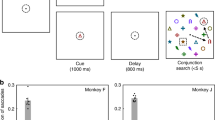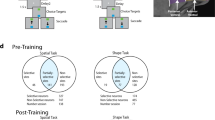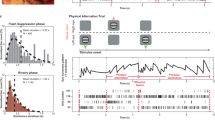Abstract
Single neuron, evoked potential and metabolic techniques show that attention influences visual processing in extrastriate cortex. We provide anatomical, electrophysiological and behavioral evidence that prefrontal cortex regulates neuronal activity in extrastriate cortex during visual discrimination. Event-related potentials (ERPs) were recorded during a visual detection task in patients with damage in dorsolateral prefrontal cortex. Prefrontal damage reduced neuronal activity in extrastriate cortex of the lesioned hemisphere. These electrophysiological abnormalities, beginning 125 ms after stimulation and lasting for another 500 ms, were accompanied by behavioral deficits in detection ability in the contralesional hemifield. The results provide evidence for intrahemispheric prefrontal modulation of visual processing.
This is a preview of subscription content, access via your institution
Access options
Subscribe to this journal
Receive 12 print issues and online access
$209.00 per year
only $17.42 per issue
Buy this article
- Purchase on Springer Link
- Instant access to full article PDF
Prices may be subject to local taxes which are calculated during checkout



Similar content being viewed by others
References
Hillyard, S. A., Mangun, G. R., Woldorff, M. G. & Luck, S. J. in The Cognitive Neurosciences (ed. Gazzaniga, M. S.) 665–681 (MIT Press, Cambridge, Massachusetts, 1995).
Hillyard, S. A. & Anllo-Vento, L. Event-related brain potentials in the study of visual selective attention. Proc. Natl. Acad. Sci. USA 95, 781–787 (1998).
Luck, S. J. Multiple mechanisms of visual-spatial attention: recent evidence from human electrophysiology. Behav. Brain Res. 71, 113–123 (1995).
Müller, M. M., Teder-Salejarvi, W. & Hillyard, S. A. The time course of cortical facilitation during cued shifts of spatial attention. Nat. Neurosci. 1, 631–634 (1998).
Wijers, A. A., Lange, J. J., Mulder, G. & Mulder, L. J. M. An ERP study of visual spatial attention and letter target detection for isoluminant and nonisoluminant stimuli. Psychophysiology 34, 553–565 (1997).
Mangun, G. R. Neural mechanisms of visual selective attention. Psychophysiology 32, 4–18 (1995).
Desimone, R. & Duncan, J. Neural mechanisms of selective visual attention. Annu. Rev. Neurosci. 18, 193–222 (1995).
Posner, M. I. & Dehaene, S. Attentional networks. Trends Neurosci. 17, 75–79 (1994).
Webster, M. J. & Ungerleider, L. G. in The Attentive Brain (ed. Parasuraman, R.) 19–34 (MIT Press, Cambridge, Massachusetts 1999).
Webster, M. J., Bachevalier, J. & Ungerleider, L. G. Connections of inferior temporal areas TEO and TE with parietal and frontal cortex in macaque monkeys. Cereb. Cortex 5, 470–483 (1994).
Tomita, H., Ohbayashi, M., Nakahara, K., Hasegawa, I. & Miyashita, Y. Top-down signal from prefrontal cortex in executive control of memory retrieval. Nature 401, 699–703 (1999).
Wilson, F. A. W., Scalaidhe, P. O. & Goldman-Rakic, P. S. Dissociation of object and spatial processing domains in primate prefrontal cortex. Science 260, 1955–1958 (1993).
Rainer, G., Asaad, W. F. & Miller, E. K. Selective representation of relevant information by neurons in the primate prefrontal cortex. Nature 393, 577–579 (1998).
Rao, S. C., Rainer, G. & Miller, E. K. Integration of what and where in the primate prefrontal cortex. Science 276, 821–824 (1997).
Knight, R. T. A distributed cortical network for visual attention. J. Cogn. Neurosci. 9, 75–91 (1997).
Nielsen-Bohlman, L. C. & Knight, R. T. Prefrontal cortex involvement in visual working memory. Cogn. Brain Res. 8, 299–310, 1999.
Büchel, C. & Friston, K. J. Modulation of connectivity in visual pathways by attention: Cortical interactions evaluated with structural equation modeling and fMRI. Cereb. Cortex 7, 768–778 (1997).
Chawla, D., Rees, G. & Friston, K. J. The physiological basis of attentional modulation in extrastriate visual areas. Nat. Neurosci. 2, 671–676 (1999).
Rees, G., Frackowiak, R. & Frith, C. Two modulatory effects of attention that mediate object categorization in human cortex. Science 275, 835–838 (1997).
Kastner, S., Pinsk, M. A., De Weerd, P., Desimone, R. & Ungerleider, L. G. Increased activity in human visual cortex during directed attention in the absence of visual stimulation. Neuron 22, 751–761 (1999).
McIntosh, A. R. et al. Network analysis of cortical visual pathways mapped with PET. J. Neurosci. 14, 655–666 (1994).
Corbetta, M., Miezin, F. M., Shulman, G. L. & Petersen, S. E. A PET study of visuospatial attention. J. Neurosci. 13, 1202–1226 (1993).
Corbetta, M. Frontoparietal cortical networks for directing attention and the eye to visual locations: Identical, independent, or overlapping neural systems? Proc. Natl. Acad. Sci. USA 95, 831–838 (1998).
Tootell, R. B. H. et al. The retinotopy of visual spatial attention. Neuron 21, 1409–1422 (1998).
Heinze, H. J. et al. Combined spatial and temporal imaging of brain activity during visual selective attention in humans. Nature 372, 543–546 (1994).
Martinez, A. et al. Involvement of striate and extrastriate visual cortices areas in spatial attention. Nat. Neurosci. 2, 364–369 (1999).
Clark, V. P., Fan, S. & Hillyard, S. A. Identification of early visual evoked potential generators by retinotopic and topographic analyses. Hum. Brain Mapp. 2, 170–187 (1995).
Woldorff, M. G. et al. Retinotopic organization of early visual spatial attention: effects as revealed by PET and ERP data. Hum. Brain Mapp. 5 280–286 (1997).
Luck, S. J., Chelazzi, L., Hillyard, S. A. & Desimone, R. Neural mechanisms of spatial selective attention in areas V1, V2, and V4 of macaque visual cortex. J. Neurophysiol. 77, 24–42 (1997).
Smid, H. G. O. M., Jakob, A. & Heinze, H.-J. An event-related brain potential study of visual selective attention to conjunctions of color and shape. Psychophysiology 36, 264–279 (1999).
Hansen, J. C. & Hillyard, S. A. Endogenous brain potentials associated with selective auditory attention. Electroencephalogr. Clin. Neurophysiol. 49, 277–290 (1980).
Karayanidis, F. & Michie, P. T. Evidence of visual processing negativity with attention to orientation and color in central space. Electroencephalogr. Clin. Neurophysiol. 103, 282–297 (1997).
McCarthy, G. & Wood, C. C. Scalp distributions of event-related potentials: an ambiguity associated with analysis of variance models. Electroencephalogr. Clin. Neurophysiol. 62, 203–208 (1985).
Valdes-Sosa, M., Bobes, M. A., Rodríguez, V. & Pinilla, T. Switching attention without shifting the spotlight: object-based attentional modulation of brain potentials. J. Cogn. Neurosci. 10, 137–151 (1998).
Miller, E. K. The prefrontal cortex: Complex neural properties for complex behavior. Neuron 22, 15–17 (1999).
Chao, L. L. & Knight, R. T. Contribution of human prefrontal cortex to delay performance. J. Cogn. Neurosci. 10, 167–177 (1998).
Rosahl, S. K. & Knight, R. T. Role of prefrontal cortex in generation of the contingent negative variation. Cereb. Cortex 2, 123–134 (1995).
Rajkowska, G. & Goldman-Rakic, P. S. Cytoarchitechtonic definition of prefrontal areas in the normal human cortex: I. Remapping of areas 9 and 46 using quantitative criteria. Cereb. Cortex 5, 307–322 (1995).
Rajkowska, G. & Goldman-Rakic, P. S. Cytoarchitechtonic definition of prefrontal areas in the normal human cortex: II. Variability in locations of areas 9 and 46 and relationship to the Talairach coordinate system. Cereb. Cortex 5, 323–337 (1995).
Knight, R. T. & Scabini, D. Anatomic bases of event-related potentials and their relationship to novelty detection in humans. J. Clin. Neurophysiol. 15, 3–13 (1998).
Knight, R. T. Decreased response to novel stimuli after prefrontal lesions in man. Electroencephalogr. Clin. Neurophysiol. 59, 9–20 (1984).
Acknowledgements
Supported by Fundación Complutense del Amo, Comunidad de Madrid grant 08.5/0012/98 and NINDS grant NS21135. We thank Clay C. Clayworth for technical support. An earlier version of this work was presented at the 39th Meeting of the Society for Psychophysiological Research (Granada 1999).
Author information
Authors and Affiliations
Corresponding author
Rights and permissions
About this article
Cite this article
Barceló, F., Suwazono, S. & Knight, R. Prefrontal modulation of visual processing in humans. Nat Neurosci 3, 399–403 (2000). https://doi.org/10.1038/73975
Received:
Accepted:
Issue Date:
DOI: https://doi.org/10.1038/73975
This article is cited by
-
A Legion of Lesions: The Neuroscientific Rout of Higher-Order Thought Theory
Erkenntnis (2023)
-
The mnemonic basis of subjective experience
Nature Reviews Psychology (2022)
-
Rhythmic interactions between the mediodorsal thalamus and prefrontal cortex precede human visual perception
Nature Communications (2022)
-
Top-down control of visual cortex by the frontal eye fields through oscillatory realignment
Nature Communications (2021)
-
Attention expedites target selection by prioritizing the neural processing of distractor features
Communications Biology (2021)



